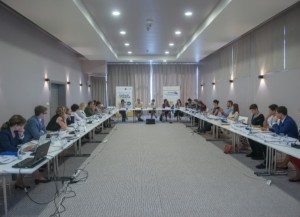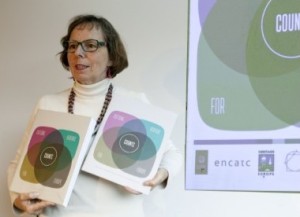
Claire Giraud-Labalte, member of the CHCFE Steering Committee on behalf of ENCATC and chair of the ENCATC Thematic Area Chair of “Understanding Heritage”
The results of the Cultural Heritage Counts for Europe project were presented to the Reflection Group “EU and Cultural Heritage” during their meeting held from 23-25 September in Luxembourg. Reflection group member, Claire Giraud-Labalte, member of the CHCFE Steering Committee, ENCATC Thematic Area Chair of “Understanding Heritage” and ENCATC Ambassador, was invited to present the project’s final publication and key findings along with Piet Jaspaert, Vice-President, Europa Nostra and member of the CHCFE Steering Committee. With an audience of representatives from European institutions, UNESCO, European heritage institutes and monuments and heritage networks, it was crucial to share the project results to ensure key players in policy and heritage have the resource to provide concrete evidence of the impact of cultural heritage on the economy, society, culture and the environment.
This meeting was also the opportunity for participants to discuss the importance to cultural heritage and international relations, as well as the international dimensions inherent to local heritage, be it historical or contemporary. The 3-day programme included expert testimony from UNESCO, the Council of Europe, the European Investment Bank, European heritage and cultural networks, and national governments. Participants were also invited to study visits to discover local heritage and meet with operators in the field.
The Reflection group “EU and cultural heritage” was established during the Belgian Presidency of the Council of the European Union in 2010. Its mission, according to the Declaration of Bruges, is to study the impact on cultural heritage of EU legislation and policies and to ensure ways so that the potential of cultural heritage is better accentuated and disseminated. The Reflection Group on “EU and Cultural Heritage” composed of the representatives of EU Members States and also of European networks active in the field of cultural heritage.
The forum ‘Cultural Heritage Works for South East Europe’ took place on 23 September 2015, in Igalo, Montenegro. This event brought together public and civil society stakeholders from the European Union (EU) and South East Europe (SEE) to discuss the real policy momentum for heritage and formulate concrete proposals on the new phase of regional cooperation in this field. The forum was followed by the 12th meeting of the Regional Cooperation Council Task Force on Culture and Society (RCC-TFCS) the next day. On this occasion, the results and recommendations of the ‘Cultural Heritage Counts for Europe’ project were presented. Sneška Quaedvlieg-Mihailović, Secretary General of Europa Nostra, also representing the European Heritage Alliance 3.3., participated in the events.
The forum was opened by: Asja Drača Muntean, TFCS Chair and Assistant Minister of Culture and Information in the Republic of Serbia; Sanjin Arifagić, SEE2020 Coordinator at the Regional Cooperation Council; Wenceslas de Lobkowicz, Advisor at the DG for Neighbourhood and Enlargement Negotiations of the European Commission; and Sneška Quaedvlieg-Mihailović, Secretary General of Europa Nostra and member of the Cultural Heritage Counts for Europe (CHCFE) Steering Committee.
Sneška Quaedvlieg-Mihailović noted the evident policy shifts caused by the increased recognition of the importance, impact and value of cultural heritage in the EU and highlighted the need to include the SEE region in these developments through strengthened participatory approaches. She also underlined the priority of tackling the ongoing refugee crisis in Europe and advocated the crucial role that heritage can play in fostering regional and intercultural dialogue. Finally, the Secretary General of Europa Nostra, also acting on behalf of the European Heritage Alliance 3.3, emphasised the significance of the initiative in organising a European Year of Cultural Heritage in 2018, thus providing a target to aim for to show that cultural heritage indeed works for Europe and SEE.
The meeting featured three thematic panel discussions: Cultural Heritage Counts for (South East) Europe (moderated by Brian Smith, Secretary General of the European Association of Historic Towns and Regions and member of the CHCFE Steering Committee); Participatory governance of cultural heritage in the EU and its implications in SEE (moderated by Sneška Quaedvlieg Mihailović); and Cultural Heritage in SEE: towards a new momentum for regional cooperation (moderated by Wenceslas de Lobkowicz).
“The participants agreed to open a new phase of the Ljubljana Process by reaching out to other stakeholders with a view to building stronger partnerships for the benefit of cultural heritage in South East Europe. This new phase of regional cooperation should duly reflect the recent important EU policy developments which recognise heritage as a strategic resource and a driver of sustainable development in Europe and which promote an integrated approach to cultural heritage at all levels of governance (local, national, regional and European). The focus should be to ensure effective implementation of these newest policy developments throughout the region,” reads the meetings’ Conclusions.
“The Task Force on Culture and Society is encouraged to promote a holistic approach to measuring the impact of cultural heritage and in that respect the key findings and recommendations of the ‘Cultural Heritage Counts for Europe’ report could serve as a useful reference in the longer term. The TFCS is also encouraged to promote the value of and the need for participatory governance in cultural heritage which seeks to ensure the appropriate involvement of all relevant stakeholders, including communities, civil society organisations, research circles and the business sector,” the Conclusions state.
The meeting gathered delegates from the Regional Cooperation Council and the European Commission, TFCS members from Albania, Bosnia and Herzegovina, Croatia, Greece, Kosovo, Moldova, Montenegro and Serbia, and representatives from organisations based in various countries – Albania (Cultural Heritage without Borders), Bosnia and Herzegovina (Balkans Museum Network), Montenegro (Expeditio), the United Kingdom (Heritage Europe and North of England Civil Trust), Romania (Architecture Restoration Archaeology) and Serbia (Europa Nostra Serbia) – the majority of which are also part of Europa Nostra’s network.
Inspiracją dla rozpoczęcia projektu badawczego Cultural Heritage Counts for Europe (Dziedzictwo kulturowe ma znaczenie dla Europy) stało się przekonanie o potencjale drzemiącym w dziedzictwie kulturowym. Rezultatem tej inicjatywy jest raport, który prezentuje wieloaspektowy i holistyczny wpływ dziedzictwa na różne sfery życia – gospodarkę, społeczeństwo, kulturę i środowisko naturalne. Na przykładzie projektów z różnych krajów europejskich twórcy raportu pokazują, w jaki sposób dziedzictwo przyczynia się do tworzenia miejsc pracy, jak przekłada się na stymulowanie działalności gospodarczej w regionie i na wzrost jego konkurencyjności, jakiego rodzaju zmianę społeczną może spowodować, w jaki sposób buduje atrakcyjność miejsca, wreszcie – jaki jest związek między dziedzictwem kulturowym a ochroną środowiska.
DOWNLOAD: DZIEDZIC TWO KULTUROWE MA ZNACZENIE DLA EUROPY – SKRÓT RAPORTU
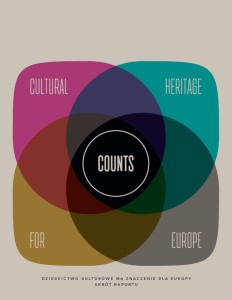 |
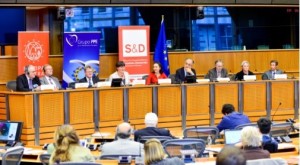
FAVEL Bruno, KOCH Uwe, SMITH Brian, QUAEDVLIEG-MIHAILOVIC Sneska, TAPARDEL, Claudia, MILLAN MON, Francisco Jose (EPP,ES), CLAUSSE Guy, PUGH Kate, ZAMPIERI Walter
Meeting of the intergroup on European tourism development, cultural heritage, Ways of St. James and other European cultural routes
© European Union 2015 – Source : EP
On 16 September in Brussels, the results of the ‘Cultural Heritage Counts for Europe’ (CHCFE) project were presented to the Members of the European Parliament in Brussels during the meeting of the Intergroup on European tourism development, cultural heritage.
Following just a week after the adoption by the European Parliament of a Resolution calling for the implementation of an integrated approach to cultural heritage for Europe (with over 80% of MEPs voting in favour), cultural heritage was at the heart of discussions of this first ever meeting of the European Parliament Intergroup on European tourism development, cultural heritage and the Way of St James and other cultural routes. This meeting gathered over 100 participants from the European Union Institutions, representatives of EU Member States and Regions, European civil society and the private sector. Co-organised by Europa Nostra, leader partner of the Cultural Hertiage Counts for Europe project, and the Co-Chair of the Intergroup, Ana-Claudia Tapardel (S&D, Romania), with the support of the other Co-Chair, Francisco Millan Mon (EPP, Spain), this meeting was dedicated to the presentation of the results of the Cultural Heritage Counts for Europe project. It provided an ideal platform to join forces in support of cultural heritage as a key resource for sustainable development in Europe and also as a vital tool for promoting the much needed inter-cultural dialogue within Europe and also between Europe and the rest of the world.
Silvia Costa, Chair of the EP Committee on Culture and Education, opened the meeting by praising the importance of the Cultural Heritage Counts for Europe report. She recalled the hearing on Intercultural dialogue and education for mutual understanding organised by her Committee the previous day (15/09) with the participation of Irina Bokova, Director General of UNESCO, as a key-note speaker. “We must condemn any act of deliberate destruction of cultural heritage and we must use the power of cultural heritage to foster Europe’s cultural diplomacy and to promote intercultural dialogue in Europe and beyond,” said Silvia Costa.
Speaking on behalf of Europa Nostra, the European Heritage Alliance 3.3 and members of the Cultural Heritage Counts for Europe consortium, Sneska Quaedvlieg-Mihailovic, Europa Nostra’s Secretary General, welcomed the establishment of the EP Intergroup covering cultural heritage as a transversal policy issue and expressed the hope that from now on the dialogue between Europe’s various stakeholders, including civil society and MEPs will become much more regular and more effective. She also referred to the tragic exodus of people coming to Europe in search of safety and hope for a better life. She argued that “host countries and communities should be prepared to learn about and respect the immaterial heritage these hundreds of thousands of people are bringing with them while at the same time finding the proper ways to help the refugees to learn about and respect the culture and heritage of their new living environment”.
The two-hour discussion was rich in examples of how cultural heritage counts for Europe. Speaking on behalf of the CHCFE Consortium, Kate Pugh of the Heritage Alliance presented the results and implications of the ‘Cultural Heritage Counts for Europe’ Report which was produced in June 2015 by a European consortium composed of six partners, using a series of concrete examples which are in the report. She closed her intervention by underlining that Europe should be deploying much more its soft power, including the power of its cultural heritage. Guy Clausse, Dean of the European Investment Bank Institute (EIBI), presented ‘The 7 Most Endangered’ programme run by Europa Nostra in partnership with EIBI and stressed the need for stronger pooling of resources between local, regional, national and European authorities to ensure the necessary funding for saving Europe’s (endangered) heritage. Uwe Koch of the German National Heritage Committee presented the concept note, under preparation by the Reflection Group “EU and Cultural Heritage”, on the proposed European Year of Cultural Heritage in 2018, putting forward the central theme of the Year: “sharing heritage”, which “allows for everyone to discover and to join in on how to share heritage”.
The discussion also gave an audible voice to a series of vital actors in the conception and implementation of any credible policy towards cultural heritage, namely: the Council of Europe, the European Commission and historic towns and regions. In his reaction to the first panel, Bruno Favel, Chair of the Steering Committee for Culture, Heritage and Landscape of the Council of Europe, payed tribute to Khaled al-Asaad, the late archaeologist looking after the site of Palmyra for 40 years and who was killed by Islamic State (IS) militants this August, and made a strong plea to perceive and use cultural heritage as a vehicle for intercultural dialogue and respect. Walter Zampieri, Head of Unit in the DG for Education and Culture of the European Commission, presented the active role of the European Commission in this field over the past few years and thanked the European Parliament and the European civil society, especially Europa Nostra and the European Heritage Alliance 3.3, for a constructive partnership. Brian Smith, Secretary General of the European Association of Historic Towns and Regions, called for the need to shift the momentum from the European level to the national, regional and local levels – in particular historic towns and regions. He also welcomed the possibility of having a cultural heritage year in 2018 to provide “real focus for action and change”.
Closing the meeting, the President of the European Socialists and Democrats, Gianni Pittella, congratulated the Consortium for the ‘Cultural Heritage Counts for Europe’ Report and underlined the importance of recognising the immense added value of cultural heritage, stating that “Europe as we know it today is the result of a long history where the values of diversity, tolerance and multiculturalism have always played an important role. Our cultural heritage is the best testimony ever of the very rich history of the European continent”.
Speeches and Presentations
Speech by Brian Smith, CHCFE Steering Committee Member | Download here.
Speech by Kate Pugh, CHCFE Steering Committee Member | Download here.
Presentation by Kate Pugh, CHCFE Steering Committee Member | Download here.
Background Information
European Parliament Intergroups are informal groupings of MEPs from different countries and different political parties gathering to discuss transversal policy issues for which they share an interest and which they wish to promote. Such Intergroups also provide a suitable platform for MEPs to engage in a regular dialogue with various stakeholders, including civil society and the private sector.
For more information related to Intergroups, click here.
For the composition of the EP Intergroup on European tourism development, cultural heritage and the Way of St James and other cultural routes click here.
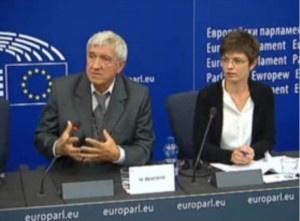
Mircea Diaconu, CULT rapporteur, speaking about the Report/EP Resolution ‘Towards an integrated approach to cultural heritage for Europe’ at a press conference held at the European Parliament on 8 September 2015. Photo: EP
On 8 September in Brussels, Members of the European Parliament recognised the vital role of heritage in Europe and the opportunities it represents for Europe’s economy and development by adopting with a large majority (613 votes in favour, 70 against and 19 abstentions) a Resolution calling for the implementation of an integrated approach towards cultural heritage for Europe. During the debate preceding the vote, the Rapporteur from Romania, Mircea Diaconu, described his report as a tool “to convince the political authorities of the importance of cultural heritage”. The Chair of the Education and Cultural Committee, Silvia Costa, also mentioned the relevance of communicating the importance of heritage to the European Commission to ensure the continuity of efforts in this field. For his part, European Commissioner Tibor Navracsics clearly stated the European Commission shares the view that “supporting, enhancing and promoting cultural heritage through an integrated approach is of paramount importance”.
This major policy development has occurred only several months after the Cultural Heritage Counts for Europe consortium published its final report for tapping into heritage’s full potential with compelling evidence of the value of cultural heritage and its impact on Europe’s economy, culture, society and the environment.
The past year has seen a momentum of political support for European heritage. The European Parliament’s resolution adoption on 8 September demonstrates renewed European commitment towards cultural heritage following the Conclusions of the Greek and Italian Presidencies (adopted in May 2014 and November 2014) and the Communication of the European Commission published in July 2014.
“We are particularly thankful to the European Parliament for sending such a strong message to the European Commission and the Member States that cultural heritage counts for Europe in a variety of ways. We wholeheartedly support the policy recommendations put forward in the Resolution, starting with the call to designate 2018 as the European Year of Cultural Heritage,” stated Secretary General Sneska Quaedvlieg-Mihailovic from Europa Nostra, the CHCFE project leader.
Policy Recommendations included in the Resolution
Apart from the European Year of Cultural Heritage 2018, the Members of the European parliament make a series of important policy recommendations. The Resolution is composed of 5 parts:
- The first on the Integrated Approach which “Considers it of paramount importance to use the available resources for supporting, enhancing and promoting cultural heritage on the basis of an integrated approach, while taking into account the cultural, economic, social, historical, educational, environmental and scientific components” and in which the Members call for the designation of 2018 as the European Year of Cultural Heritage;
- In the second part on European funding for cultural heritage, the Members ask the European Commission to dedicate a single EU portal to tangible and intangible cultural heritage regrouping all relevant information; to review the EUR 5 million benchmark for cultural heritage projects submitted in the framework of small-scale infrastructure action, aligning it to UNESCO projects (i.e. EUR 10 million); to include a compulsory quality control system throughout projects’ life-cycle in the guidelines governing the next generation of structural finds for cultural heritage;
- The third part on New Governance models, asks, amongst others, for the introduction of a heritage impact assessment to European legislative proposals;
- In the fourth part on The economic and strategic potential of cultural heritage, the Members affirm the urgent need to give cultural heritage its clear place in the Commission’s Investment Plan for Europe. They also ask the European Commission to propose a set of indicators to develop heritage statistics to be used to monitor and evaluate the state of heritage in Europe and the Member States to emphasise the value of their heritage assets by promoting studies to determine the cultural and economic value of the cultural heritage so as to transform the ‘cost’ of its preservation into an ‘investment’ in its value;
- The fifth part on Opportunities and challenges calls for a strong commitment on all sides to prevent, protect, document and restore cultural heritage and for the adoption of international agreements to prevent illicit trafficking of cultural heritage
Download the EP resolution “Towards an integrated approach to cultural heritage for Europe” here.

